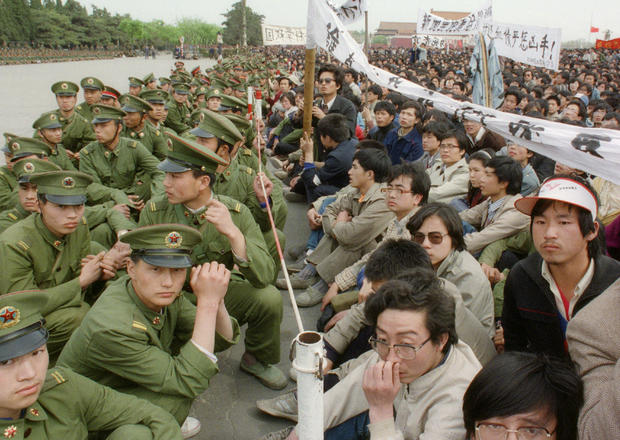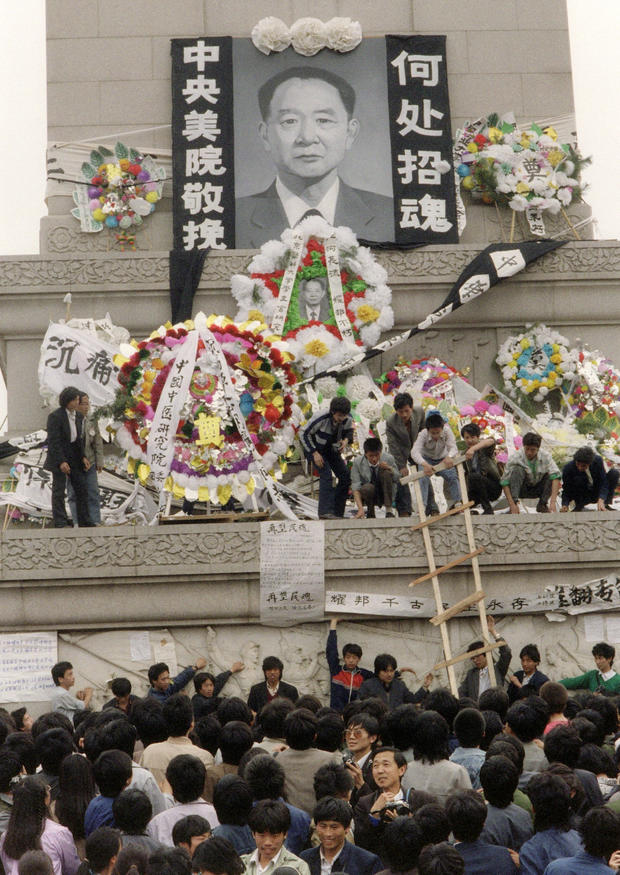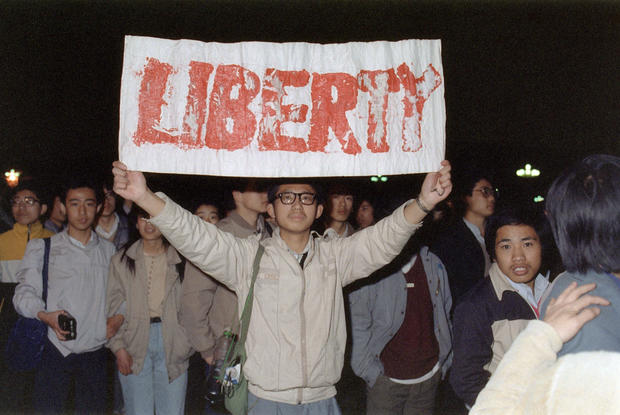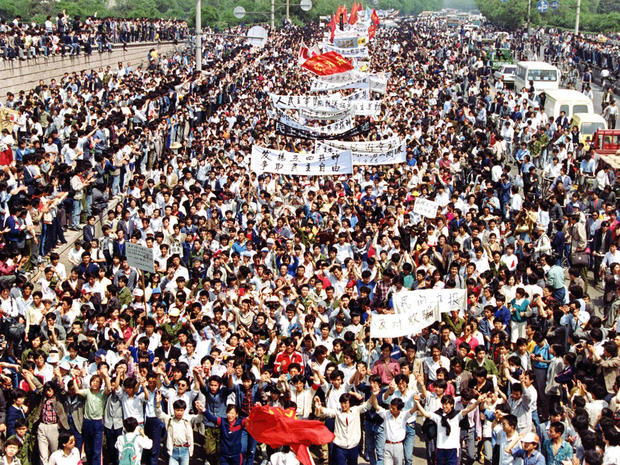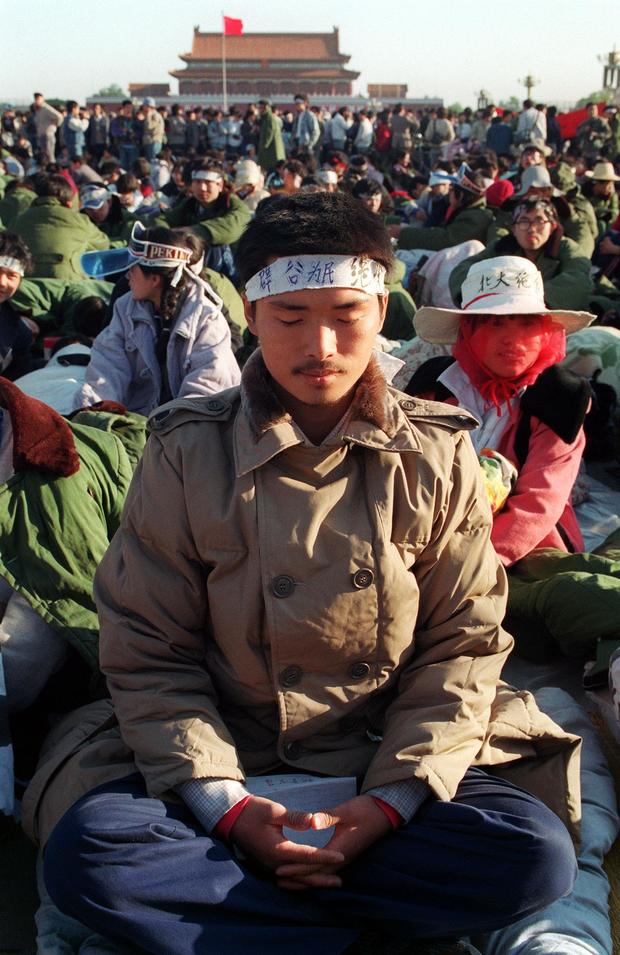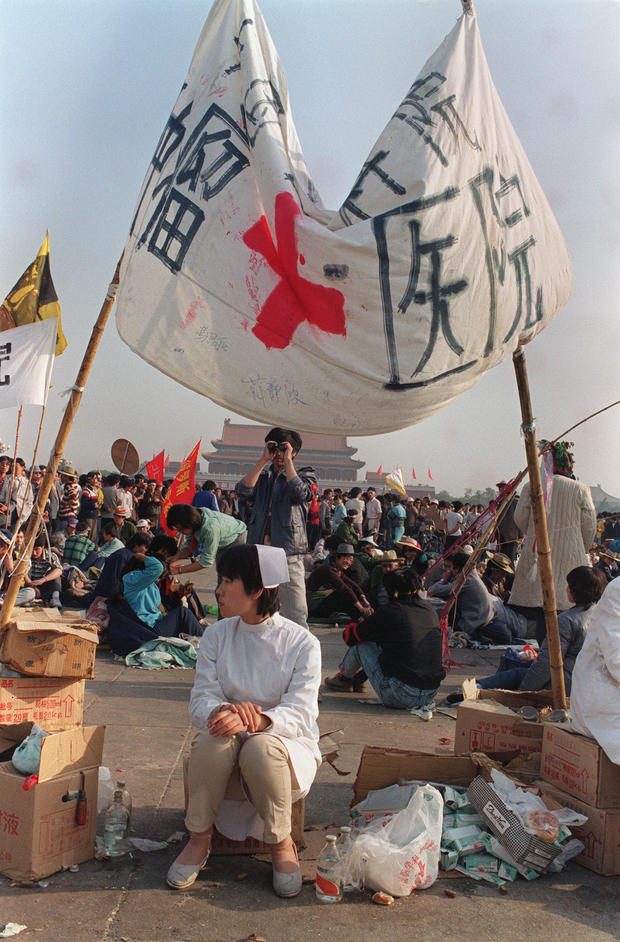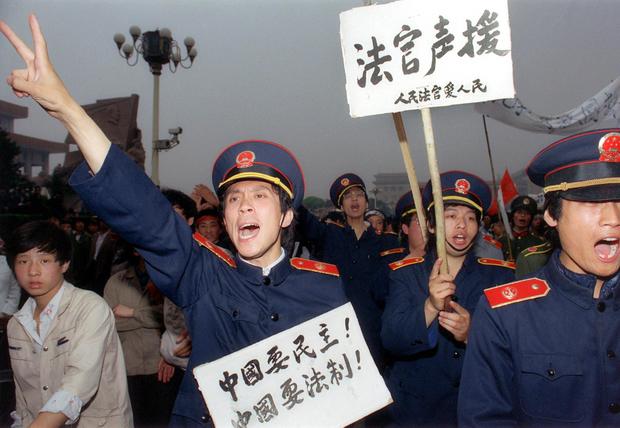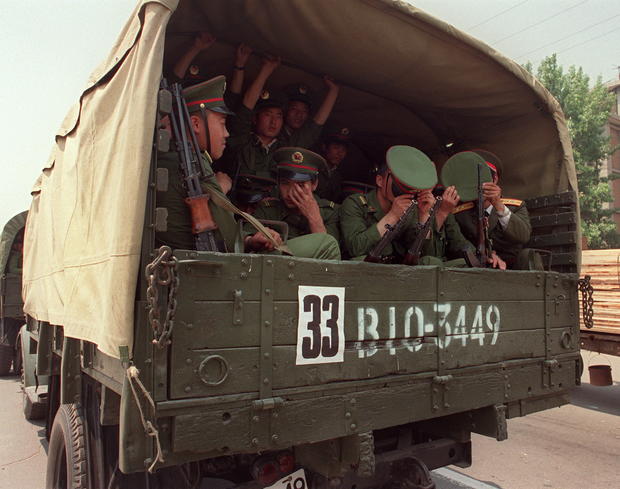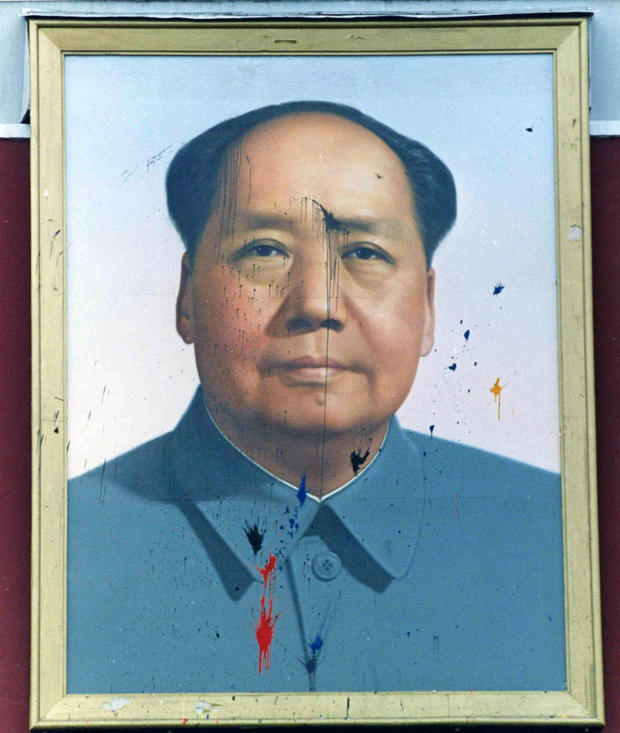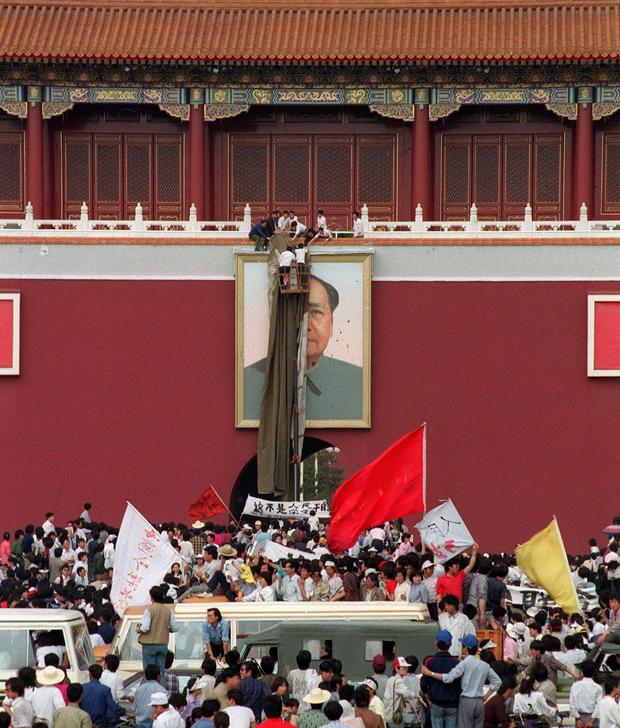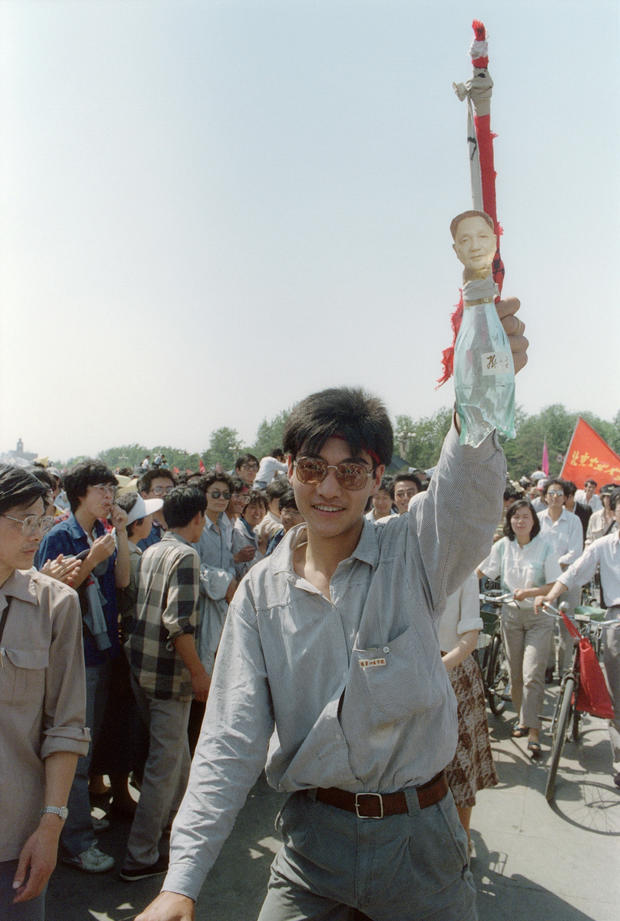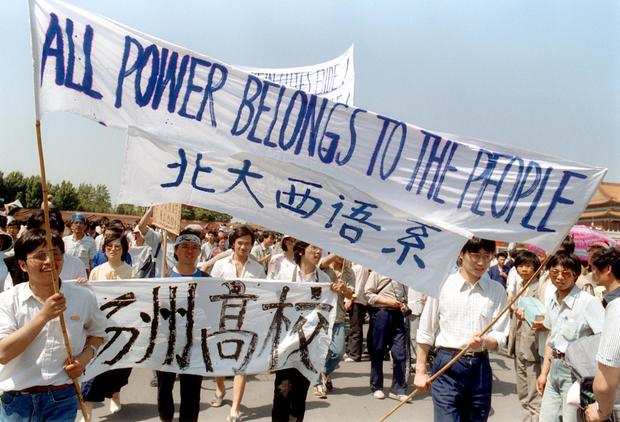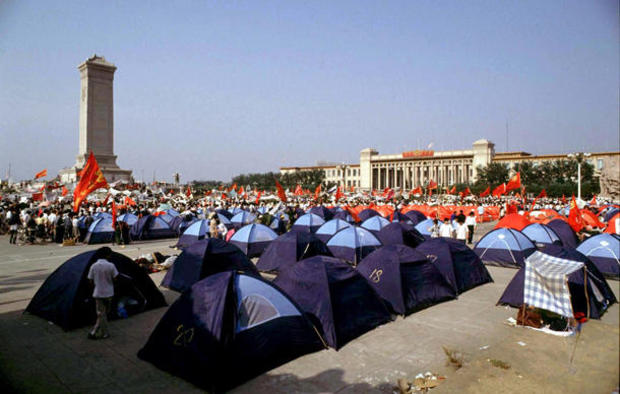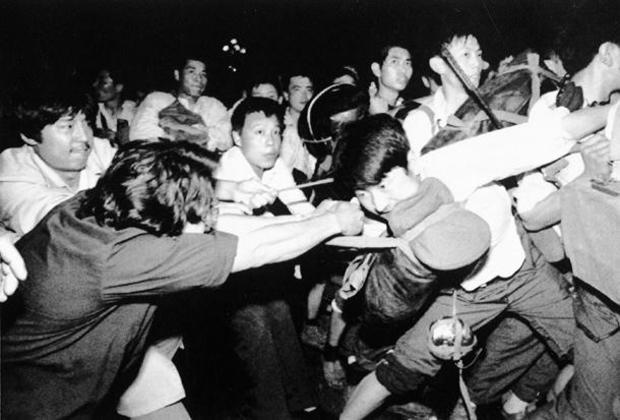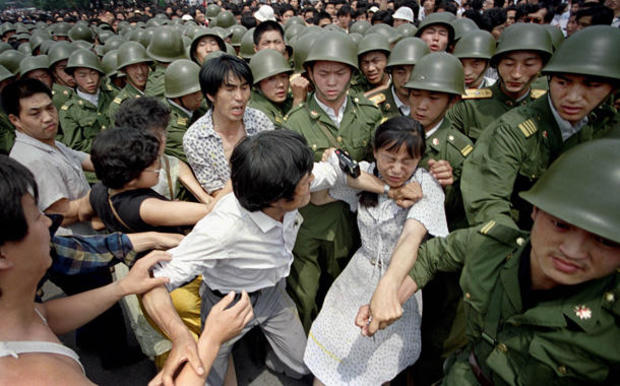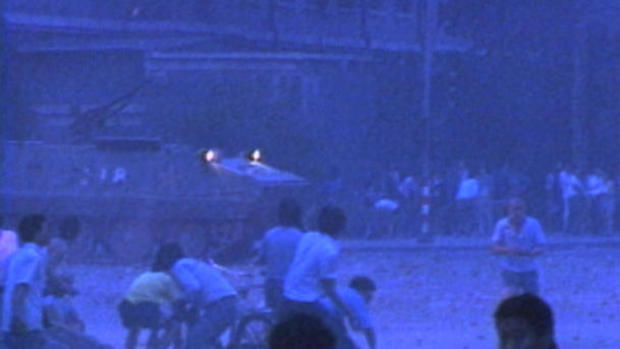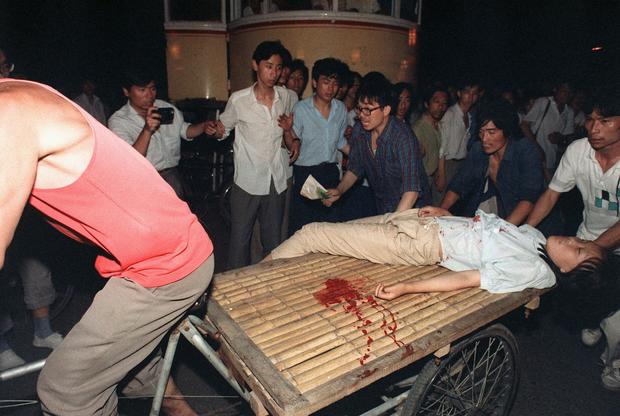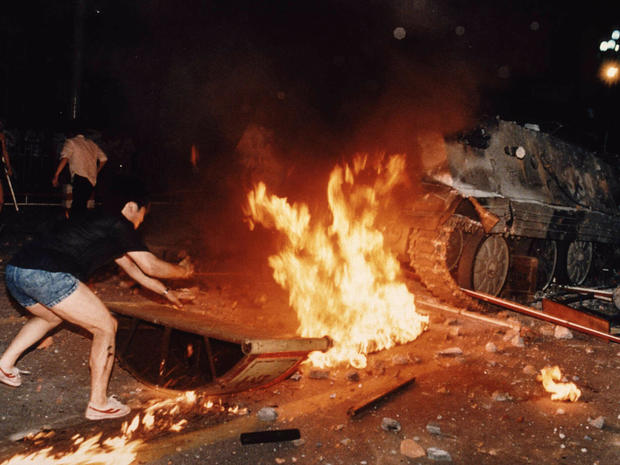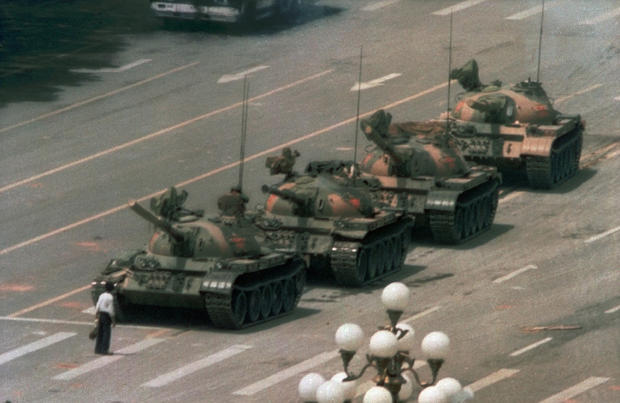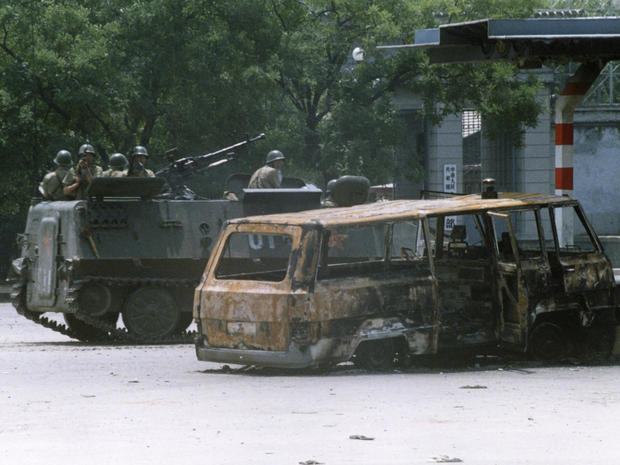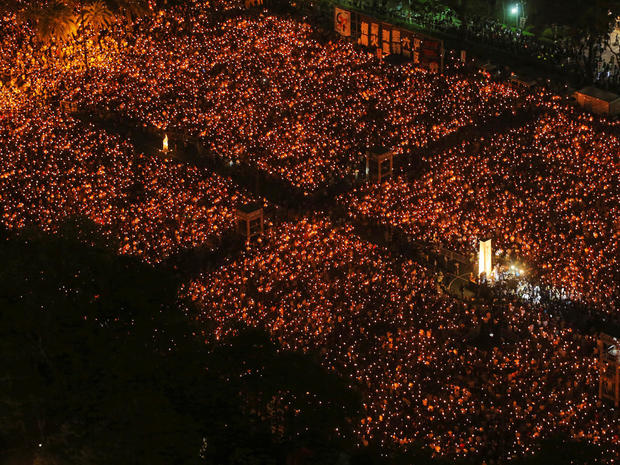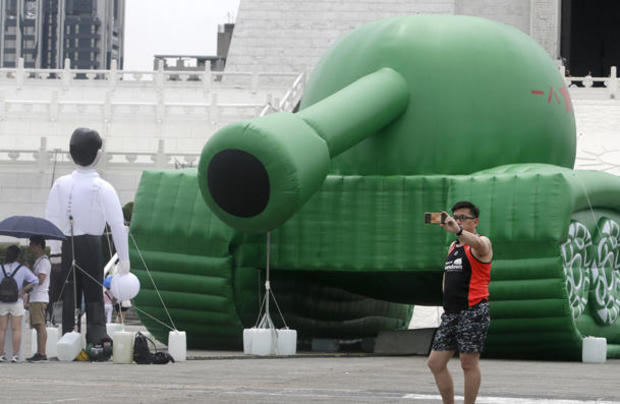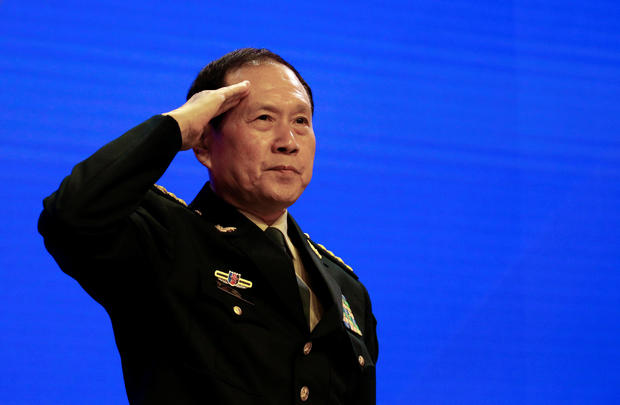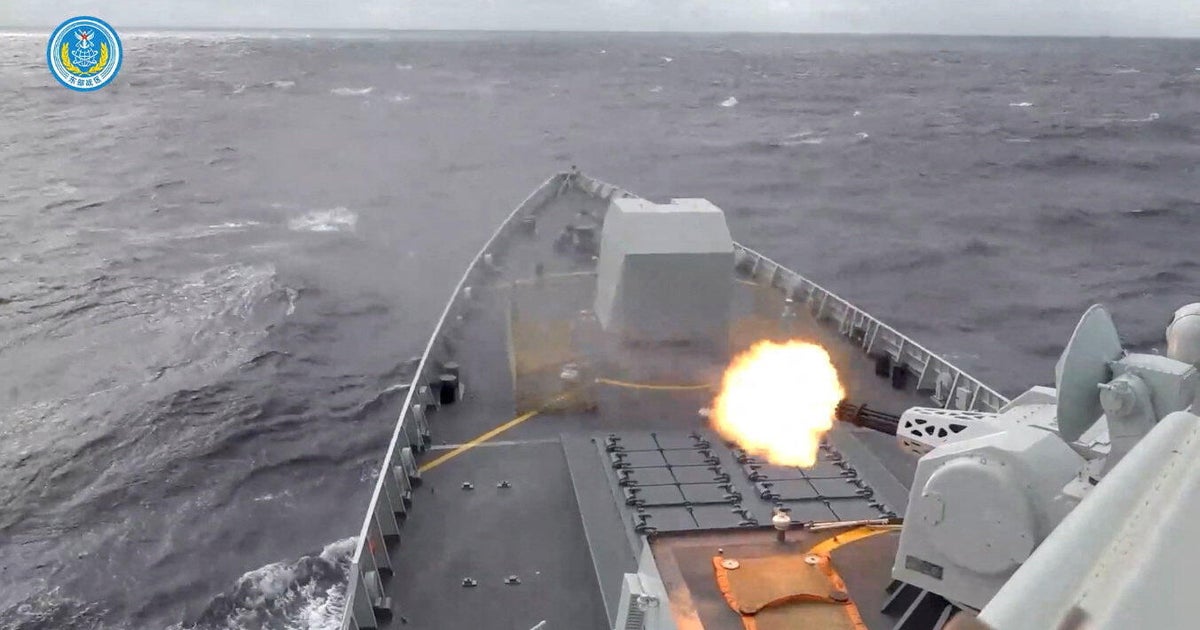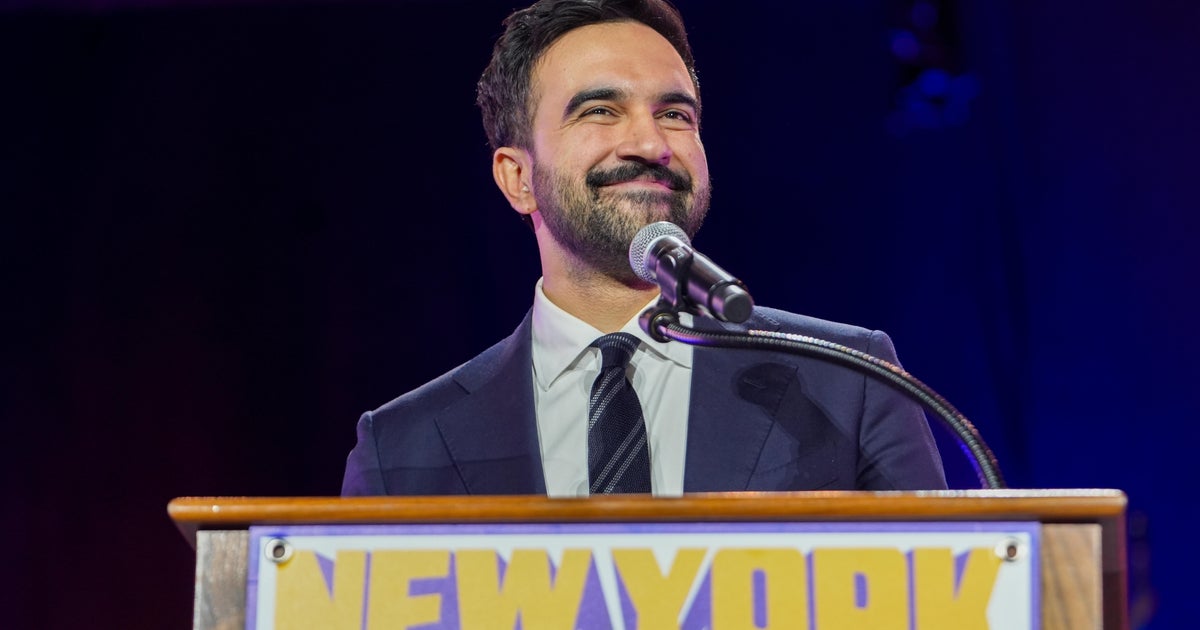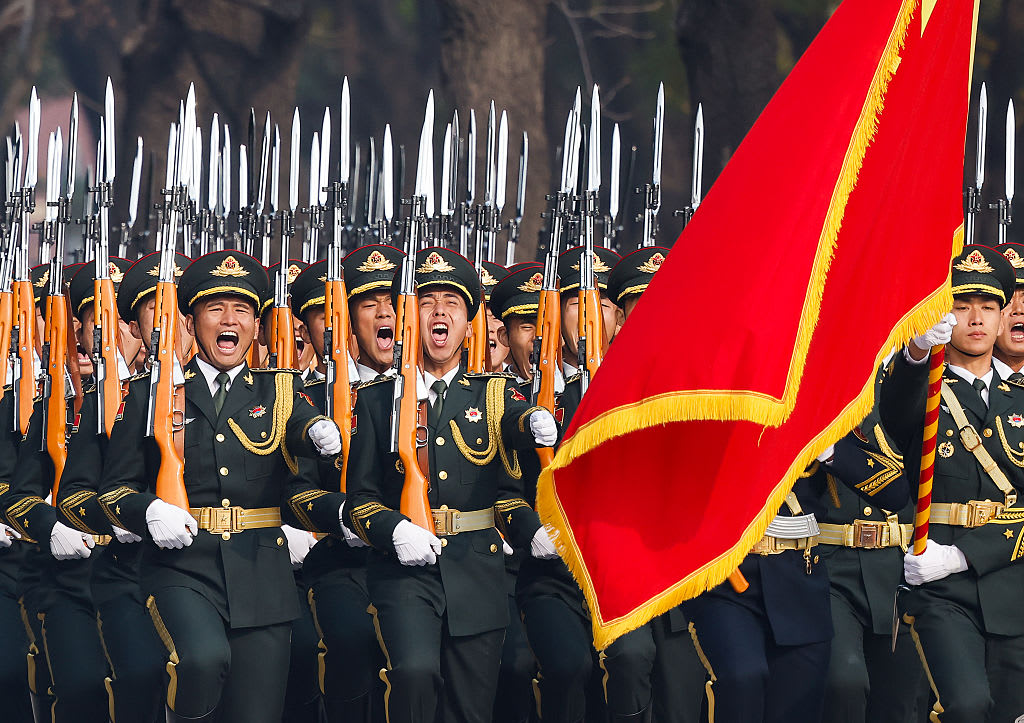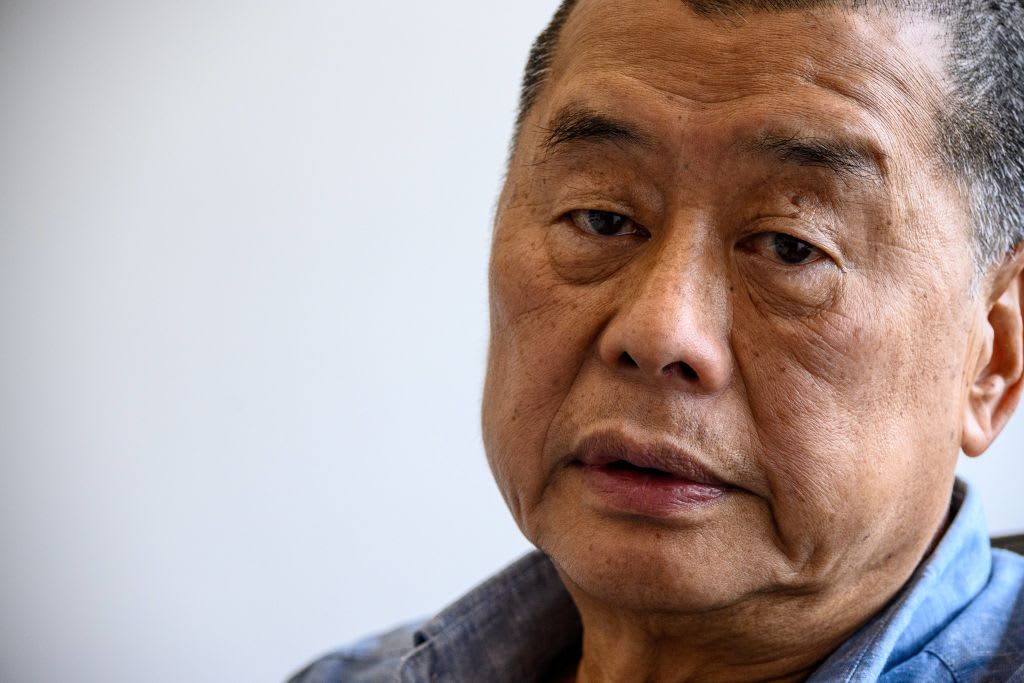Looking back at Tiananmen Square
June 4 marks the anniversary of the Chinese military's 1989 crackdown in Beijing's Tiananmen Square, in which hundreds, possibly thousands, of unarmed pro-democracy protesters and onlookers were killed.
In this file photo, several hundred student protesters stand face-to-face with policemen outside the Great Hall of the People in Tiananmen Square Beijing, as they take part in the funeral ceremony of former Chinese Communist Party leader and liberal reformer Hu Yaobang during an unauthorized demonstration to mourn his death, April 22, 1989.
Beijing, China
Beijing students put flowers and wreaths in front of a portrait of former Chinese Communist Party leader and liberal reformer Hu Yaobang as thousands of students gathered at the foot of the monument to the People's Heroes in Tiananmen Square during an unauthorized demonstration to mourn Hu's death, April 19, 1989.
His death on April 15, 1989 triggered an unprecedented wave of pro-democracy demonstrations culminating in the massacre of demonstrators by the People's Liberation Army in Tiananmen Square on the night of June 3-4, 1989.
Beijing, China
Student display a banner with one of the slogans chanted by the crowd of some 200,000 pouring into Tiananmen Square in Beijing in an attempt to participate in the funeral ceremony of former Chinese Communist Party leader and liberal reformer Hu Yaobang during an unauthorized demonstration to mourn his death, April 22, 1989.
Beijing, China
More than seven thousand students from local colleges and universities march to Tiananmen Square, Beijing, May 4, 1989, to demonstrate for government reform.
Beijing, China
Student hunger strikers from Beijing University relax as several hundred students stage a demonstration at Tiananmen Square.
They started an unlimited hunger strike as part of a mass pro-democracy protest against the Chinese government.
Beijing, China
Several hundred students staged an unlimited hunger strike as part of a mass pro-democracy protest against the Chinese government.
Beijing, China
A first-aid nurse from a local hospital under the hospital banner to take care of exhausted student hunger strikers from Beijing University at Tiananmen Square as they entered the fifth day of a marathon hunger strike, May 17, 1989.
Beijing, China
Enthusiastic demonstrators are cheered by bystanders as they arrive at Tiananmen Square to show support for the hunger strike by students protesting for government reform, May 18, 1989, in Beijing, China.
Beijing, China
Beijing magistrates wearing court uniforms join workers demonstrating in Beijing streets in support of student hunger strikers gathered at Tiananmen Square, May 18, 1989.
Beijing, China
At dawn on May 19, 1989, Chinese Communist Party (CPC) Secretary General Zhao Ziyang (center) addresses the student hunger strikers through a megaphone in one of the buses at Tiananmen Square in Beijing where pro-democracy hunger strikers had been sheltered.
Beijing, China
Armed soldiers of People's Liberation Army (PLA) hide their faces when they are photographed in Beijing on their way to Tiananmen Square after the Martial Law was proclaimed in the capital, May 20, 1989.
Beijing, China
A military helicopter drops leaflets above Tiananmen Square in Beijing, China, May 22, 1989, calling for student protesters to leave the Square as soon as possible.
Beijing, China
The famous portrait of Chairman Mao looking out over Tiananmen Square, Beijing, from the Forbidden City, May 23, 1989, was spattered with paint during the continuing demonstration in the square.
Beijing, China
Unidentified people cover a portrait of China's Communist founding father Mao Zedong with a khaki canvas after it was defaced with a trail of blue, red and yellow paint at the Tiananmen Square, May 23, 1989. A banner on the bottom can read as "This is not done by students."
Beijing, China
A student shows off a stick to which is tied a broken bottle with the picture of Chinese leader Deng Xiaoping as thousands of demonstrators gathered in Beijing streets near Tiananmen Square during a rally to support the pro-democracy protest against the Chinese government, May 25, 1989. The name "Xiaoping" also means "little bottle."
Beijing, China
Students waving banners as they march in Beijing streets near Tiananmen Square during a rally to support the pro-democracy protest against the Chinese government, May 25, 1989.
Beijing, China
A student from an art institute plasters the neck of a "Statue of Liberty," a replica of New York's Statue of Liberty, in Tiananmen Square. The statue was unveiled in front of the Great Hall of the People and the monument to the People's Heroes to promote the pro-democracy protest against the Chinese government, May 30, 1989.
Beijing, China
Pro-democracy demonstrators pitch tents in Beijing's Tiananmen Square, China, May 31, 1989.
Beijing, China
A man tries to pull a Chinese soldier away from his comrades as thousands of Beijing's citizens turned out to block thousands of troops on their way towards Tiananmen Square early Saturday morning, June 3, 1989.
Beijing, China
A young woman is caught between civilians and Chinese soldiers, who were trying to remove her from an assembly near the Great Hall of the People in Beijing, June 3, 1989.
Beijing, China
People Liberation Army (PLA) soldiers leap over a barrier on Tiananmen Square in central Beijing during heavy clashes with people and dissident students.
On the night of June 3rd and 4th, 1989, Tiananmen Square sheltered the last pro-democracy supporters. Chinese troops forcibly marched on the square to end a weeks-long occupation by student protesters, using lethal force to remove opposition it encountered along the way.
Beijing, China
Tanks enter Tiananmen Square. The "Beijing Spring" pro-democracy movement was crushed by Chinese troops when soldiers supported by tanks opened fire on demonstrators.
Beijing, China
A girl wounded during the clash between the army and students near Tiananmen Square is carried out by a cart, June 4, 1989. Hundreds of demonstrators were killed in the crackdown as tanks rolled into the environs of the square.
Beijing, China
A student protester puts barricades in the path of an already-burning armored personnel carrier that rammed through student lines during an army attack on anti-government demonstrators in Beijing's Tiananmen Square, June 4, 1989. A government soldier who escaped the armored vehicle was killed by demonstrators.
Beijing, China
An armored personnel carrier crushes one of the tents set up on Tiananmen Square by pro-democracy protesters early Sunday morning in Beijing, June 4, 1989.
Beijing, China
A Chinese man stands alone to block a line of tanks heading east on Beijing's Cangan Blvd. in Tiananmen Square, June 5, 1989.
The man, calling for an end to the violence and bloodshed against pro-democracy demonstrators, was pulled away by bystanders, and the tanks continued on their way.
The Chinese government crushed a student-led demonstration for democratic reform and against government corruption, killing hundreds, or perhaps thousands of demonstrators in the strongest anti-government protest since the 1949 revolution.
Ironically, the name Tiananmen means "Gate of Heavenly Peace."
Beijing, China
Chinese troops and tanks gather in Beijing on June 5, 1989, one day after the military crackdown that ended a seven week pro-democracy demonstration on Tiananmen Square. Hundreds were killed in the early morning hours of June 4.
Beijing, China
In this June 5, 1989 photo, Beijing residents inspect a bus that was smashed by an armored personnel carrier when the Chinese army fought its way into Tiananmen Square.
Beijing, China
The People's Liberation Army (PLA) tanks guard a strategic Chang'an Avenue leading to Tiananmen Square, June 6, 1989.
Beijing, China
In this June 7, 1989 photo,
Chinese troops patrol the street on June 7, 1989, after the army fought its way into Tiananmen Square the night of June 3-4 to reclaim the square from student-led demonstrators.
Hong Kong
Tens of thousands of people participate in a candlelight vigil at Hong Kong's Victoria Park, China on June 4, 2014, to mark the 25th anniversary of the military crackdown of the pro-democracy movement at Beijing's Tiananmen Square in 1989.
The Beijing government heavily censors mention of the military crackdown on protesters – what the government generically refers to as the "June 4th incident." The results from attempts to search "Tiananmen Square" on China's heavily-monitored internet, or even keywords like "June 4" or "6-4-89," are restricted. It is not mentioned in history books. An entire generation does not know its significance.
Taipei, Taiwan
A Taiwanese man takes a selfie with an inflatable tank man at the Liberty Square of Chiang Kai-shek Memorial Hall in Taipei, Taiwan, Saturday, June 1, 2019. An artist erected the inflatable display in Taiwan's capital to mark an iconic moment in the Tiananmen Square pro-democracy protests on the 30th anniversary of the massacre.
Defense Minister
Chinese Defense Minister Wei Fenghe. Reuters reported that on June 2, 2019, Wei said, "Everybody is concerned about Tiananmen after 30 years. Throughout the 30 years, China under the Communist Party has undergone many changes – do you think the government was wrong with the handling of June 4th? There was a conclusion to that incident. That was a political turmoil that the central government needed to quell. The government was decisive in stopping the turbulence. That was the correct policy."
Tiananmen Square Today
CBS News correspondent Elizabeth Palmer visited Tiananmen Square 30 years after the crackdown – still such a sensitive location that visitors have to show ID just to get in.
There is nothing in this vast square to remind anybody of the events of 30 years ago – not a statue, not a monument, not even a tiny plaque. The events of June 4, 1989 have been erased from Chinese history.
